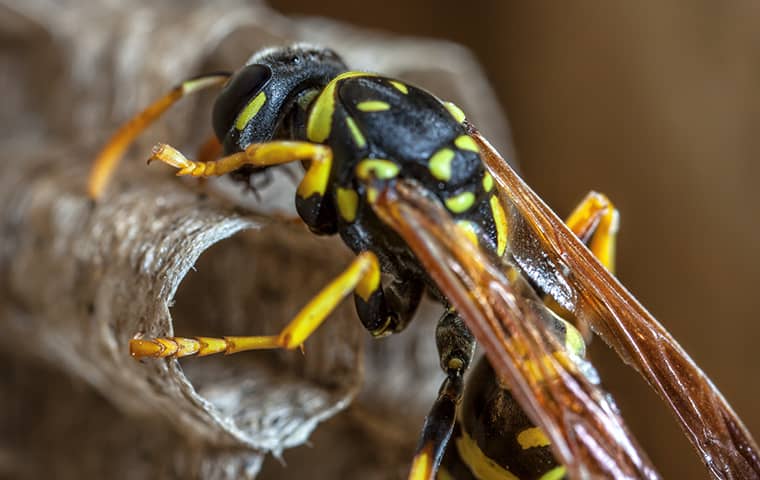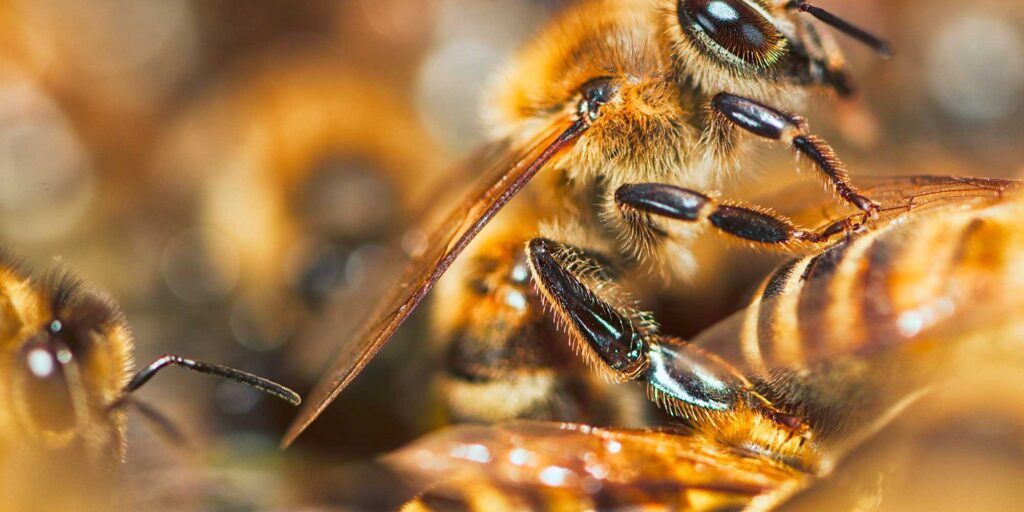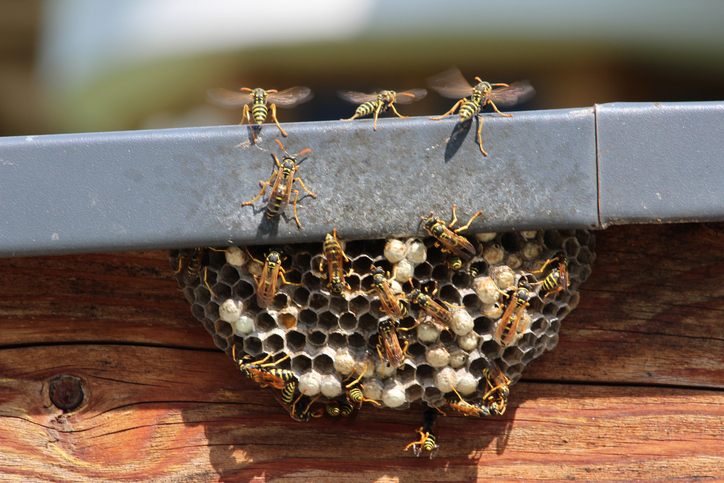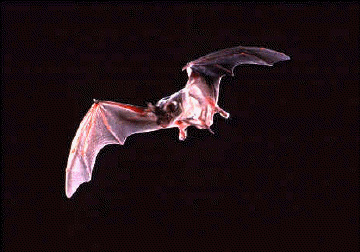Paper Wasps
What do paper wasps look like?
Paper wasps have a pinched waist and long thin legs that dangle below their body when flying. Adults grow to be between 1/2 and 1 inch in length. Their bodies are black or brown in color and have yellow or orange markings or markings that are a combination of both yellow and orange. Their wings are grayish in color. Paper wasps are semi-social and live together in small colonies. They are often identified by their umbrella-shaped nests that they create from a paper-like material.
Are paper wasps dangerous?
Paper wasps are considered beneficial because they help reduce nuisance insect numbers by hunting them to feed their colony’s developing larvae. They also feed on nectar and pollen and are responsible for pollinating a variety of crops and plants. Despite their benefits, if paper wasps decide to build a nest in or near your home, they can become a danger to you and your family. They are not an aggressive species, but will sting if they feel they are in harm’s way, are being threatened, or are being directly handled. Their venom is strong enough to cause an allergic reaction in some people which can be severe and require immediate medical attention.
Where do paper wasps nest?
Paper wasps make their nests out of a paper-like material that they create by chewing on bark, plant stems, and leaves, mixing plant material with their saliva. Paper wasps typically place their nests up off of the ground. Their nests can be found hanging from trees, shrubs, utility poles, porches, or under rooflines, decks, and door frames. If they find their way inside a home or other building they may create a nest inside the chimney, behind exterior walls, or inside a crawl space.
Why do I have a paper wasp problem?
Paper wasps have the potential to choose any property that offers them a place to nest (trees, shrubs, buildings) and easy access to food (insects, flowering plants) and water sources (areas of standing water). Paper wasps are difficult to control and prevent because almost any property can become home to a paper wasp nest.
How can I prevent future problems with paper wasps?
Preventing problems with paper wasps can be a difficult task, but there are some things you can do around your home to deter them and keep them from becoming a danger to you and your family. Trim shrubs and trees away from the exterior of your home and limit the number of flowering plants and gardens that are planted near the exterior of your home. Place tight-fitting lids on all outdoor trash cans to prevent paper wasps from foraging for food sources in them. Remove or turn over any containers that are not in use that could collect water

A COMPLETE PEST CONTROL GUIDE FOR ELIMINATING THE MENACING WASP
Did you find a wasp’s nest? Are you worried about wasp stings? Looking for a professional pest controller for wasp removal in Surrey? Here is a pest control guide to help you get rid of wasps for good.
Types of Wasps
You are most likely to encounter common wasps (Vespula vulgaris) and German Wasps (Vespula germanica) in the UK. Both these species are striped in yellow and black. Their stings cause allergic reactions with severe pain.
Why is it necessary to Control Pest?
Wasps are one of the most aggressive pests feared by all. They attack you when they feel threatened. Whenever in distress they release a pheromone alerting the defensive colony of wasps to a singing frenzy. This is the reason one should always have a backup plan ready while in a mission to eradicate them.
Treating Wasp Stings
If after a sting someone develops the following symptoms, then it is necessary to rushthem to a medical facility immediately.
Difficulties breathing
Dizziness
Swollen face
The typical household first aid to treat wasp stings are as follows,
Wash the area around the bite with soap and water.
Apply a cold compress with an ice pack for at least 10 minutes.
Keep the affected area in an elevated position if possible.
Avoid scratching the affected area.
Don’t try out any random home remedy being unaware of the consequences.

How to get rid of wasps this summer
Hot weather, warm evenings, picnics outside and al-fresco dining – the perfect conditions for one of the most annoying pests
The current heatwave is perfect for the black and yellow insects as it provides better breeding conditions. As such you may be encountering more wasps than usual at the moment, particularly if you’re spending lots of time in your garden. If you’re seeing considerable numbers of wasps in your home or garden, however, it could be that you have a nest.
Get a professional in
The quickest and most effective way of treating a wasps nest is to get someone in to deal with it. Try to get the nest removed as soon as you spot it, or spot lots of wasps returning to a particular spot in your brickwork or roof.
Do it yourself
You may choose to treat the next yourself. There are plenty of spray, foams, and powders available that can be used to kill the wasps. Apparently, one all-natural solution can be made using one part peppermint oil with four parts water. The solution is said to kill off eggs and larvae and be so unpleasant for wasps they’ll leave their nest for good.
What about the nest itself?
Leaving the nest where it is is an option but you must make sure all of the wasps have left. Once the nest is empty, if it has been treated professionally with insecticides, the poison will remain in the nest for months. That means if other wasps decide to raid the nest they too will succumb to the insecticides. This also means, however, that you should not touch the nest either.

Wasps
Being stung by a wasp or bee is a painful experience and can be life threatening to anyone who may be allergic to stings. However, it is possible to reduce these risks by taking sensible precautions when outdoors and ensuring that wasp or bee nests are properly managed.
Honey Bees
Wasps can also be confused with bees, in particular Honey Bees – however these vary in color from golden brown to almost black and are furrier than wasps. Only female wasps have a sting which they can use repeatedly, if they feel under threat. In most cases a wasp sting causes no long term harm, but it can be life threatening if you are allergic to stings. Treating a wasp nest is often the most efficient way to control a wasp problem and reduce the threat of stings.
Wasps have the potential to attack in large numbers if their nest is disturbed. It is best to treat a nest earlier in the year before numbers increase and the wasps become more aggressive, increasing the threat of stings during treatment.
Wasps can build nests outdoors under eaves or, if they can gain access, they can find sheltered areas inside your home, such as wall cavities, roof spaces and attics. If a nest is discovered you shouldn’t attempt to get rid of it yourself
How to Get Rid of Bees
Pest Control strongly recommends you to contact a pest control professionals if you have a bee infestation. Attempting to remove a bee hive by yourself can be dangerous, especially if you or someone in your family is allergic to bee stings.
Removing Bees from Your Home
In addition to the threat of insect stings, bees can also attract secondary insects to invade your home due to the honey they produce. Considering bees are highly beneficial to the environment, they should only be controlled when they pose a direct threat to your home or family.
If a bee hive/nest represents a high risk to humans, pest control professionals should be contacted to remove the bees. will only destroy a bee nest or colony if it is considered a threat to people. When possible, we will try to find a beekeeper to remove the hive.
Identifying a Wasp Nest
Wasps make their nests from chewed wood pulp and saliva, giving them distinctive papery walls. Nests are usually built in sheltered spots with easy access to the outside. You can often find wasp nests in wall cavities, roof spaces, under eaves, in bird boxes, sheds or garages.
How to Get Rid of Wasps
The most effective way to get rid of wasps or hornets is to treat the main cause of the problem – the nest. Removing a nest can be very dangerous. Wasps inside the nest will feel threatened and often become aggressive. This could cause them to sting you and others as they defend their nest and young. To reduce the risk of stings to you and your family, arrange for a professional wasp nest treatment. This effective solution will eliminate the wasps and keep you safe from the threat of stings.
